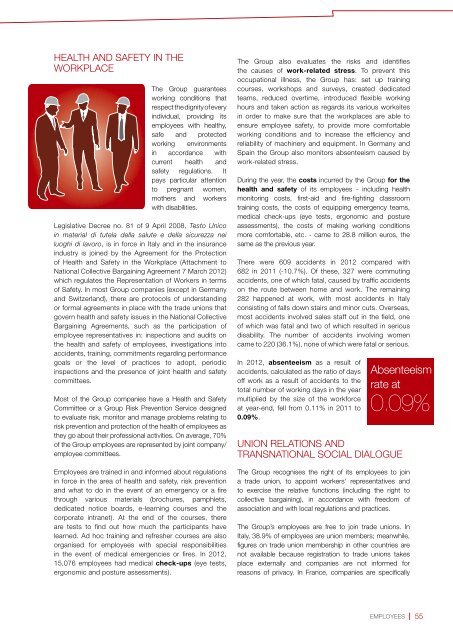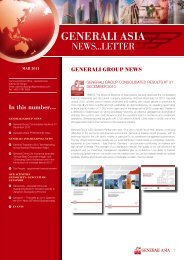<strong>2012</strong> Group training in numbersThe training data refer to the <strong>Generali</strong> Group worldwide.In <strong>2012</strong>, 6.6 million training hours were provided, 2.8 million of which to the female workforce.At global level, the number of Group employees and sales force not on the payroll involved in at least one training programmeduring the year came to over 172,000 or represented 85% of the total workforce, with an increase of 2.8% compared withthe previous year. More specifically, 83.4% of employees (88.4% of managers, 79.3% of middle managers, 76.5% of officeworkers and 100% of sales staff) and 86.1% of the sales force not on the payroll took part in training courses.Average hours of training activity by level(in million Euros)ManagersMiddleManagersOffice workersSales Forceon PayrollSales Forcenot on Payroll2011 <strong>2012</strong> 2011 <strong>2012</strong> 2011 <strong>2012</strong> 2011 <strong>2012</strong> 2011 <strong>2012</strong>Italy 18.8 11.9 26.7 13.6 19.6 12.6 18.7 29.6 49.8 34.0Austria 3.6 - 24.5 26.0 17.0 24.3 65.1 90.4 - -Czech Republic 18.7 88.2 19.6 48.2 10.3 29.4 40.1 33.8 10.9 42.0France 26.0 46.5 17.2 20.6 48.3 47.7 44.1 60.7 29.1 16.2Germany 31.5 28.7 36.1 27.5 27.7 23.4 78.8 54.8 41.9 46.0Spain 38.0 32.2 30.6 22.4 21.3 23.9 28.0 32.6 49.7 56.5Switzerland 29.1 22.7 29.8 57.6 26.8 31.4 51.7 52.8 - -Other European Countries* 50.8 50.7 52.0 40.4 27.5 25.1 33.8 44.5 18.9 50.1The Americas** 25.1 40.6 33.4 34.5 32.4 27.9 144.5 12.9 7.0 14.8Africa and Asia*** 41.8 58.3 39.2 32.9 32.7 30.8 335.6 216.7 47.7 17.1<strong>Generali</strong> Group 31.3 36.3 28.4 28.4 25.9 25.0 61.3 52.3 42.2 32.7* Belgium, Bulgaria, Croatia, Greece, Hungary, Ireland, Kazakstan, Liechtenstein, Montenegro, the Netherlands, Poland, Portugal, Romania,Russia, Serbia, Slovakia, Slovenia, Turkey, the United Kingdom.** Argentina, Brazil, Colombia, Ecuador, Guatemala, Mexico, Panama, the USA.*** China, the United Arab Emirates, Hong Kong, Indonesia, India, Philippine, South Africa, Thailand, Vietnam.In <strong>2012</strong>, the average number of training hours per capita was equal to 32.6 hours (39.8 in 2011), decreasing by 18.1% compared with2011; the figure relating to the female workforce, 32.1 hours, was consistent with this.The reduction in the number of training hours per capita was the result of the combined effect of the reorganisation activities, which sloweddown activities in Italy and Germany, and the widespread growth of e-learning courses, which generally take less time than classroomcourses.At Group level the number of training hours provided to employees at all levels increased or remained much the same. One exception isthe sales staff which, despite continuing to receive particularly intensive training, actually saw a reduction in its number of training hours percapita, as too did the sales force not on the payroll.The situations in the individual countries are very disparate and often, as a result of specific requirements, different categories of workerswithin the same country display opposing trends in terms of the number of training hours received.In <strong>2012</strong>, investment in training came to 76.8 million euros, slightly down compared to the previous year (-0.5%).The average cost of training per employee, at 379.2 euros, increased by 12.4% compared to 2011.54 | Assicurazioni <strong>Generali</strong> - <strong>Sustainability</strong> <strong>Report</strong> <strong>2012</strong>
HEALTH AND SAFETY IN THEWORKPLACEThe Group guaranteesworking conditions thatrespect the dignity of everyindividual, providing itsemployees with healthy,safe and protectedworking environmentsin accordance withcurrent health andsafety regulations. Itpays particular attentionto pregnant women,mothers and workerswith disabilities.Legislative Decree no. 81 of 9 April 2008, Testo Unicoin material di tutela della salute e della sicurezza neiluoghi di lavoro, is in force in Italy and in the insuranceindustry is joined by the Agreement for the Protectionof Health and Safety in the Workplace (Attachment toNational Collective Bargaining Agreement 7 March <strong>2012</strong>)which regulates the Representation of Workers in termsof Safety. In most Group companies (except in Germanyand Switzerland), there are protocols of understandingor formal agreements in place with the trade unions thatgovern health and safety issues in the National CollectiveBargaining Agreements, such as the participation ofemployee representatives in: inspections and audits onthe health and safety of employees, investigations intoaccidents, training, commitments regarding performancegoals or the level of practices to adopt, periodicinspections and the presence of joint health and safetycommittees.Most of the Group companies have a Health and SafetyCommittee or a Group Risk Prevention Service designedto evaluate risk, monitor and manage problems relating torisk prevention and protection of the health of employees asthey go about their professional activities. On average, 70%of the Group employees are represented by joint company/employee committees.Employees are trained in and informed about regulationsin force in the area of health and safety, risk preventionand what to do in the event of an emergency or a firethrough various materials (brochures, pamphlets,dedicated notice boards, e-learning courses and thecorporate intranet). At the end of the courses, thereare tests to find out how much the participants havelearned. Ad hoc training and refresher courses are alsoorganised for employees with special responsibilitiesin the event of medical emergencies or fires. In <strong>2012</strong>,15,076 employees had medical check-ups (eye tests,ergonomic and posture assessments).The Group also evaluates the risks and identifiesthe causes of work-related stress. To prevent thisoccupational illness, the Group has: set up trainingcourses, workshops and surveys, created dedicatedteams, reduced overtime, introduced flexible workinghours and taken action as regards its various worksitesin order to make sure that the workplaces are able toensure employee safety, to provide more comfortableworking conditions and to increase the efficiency andreliability of machinery and equipment. In Germany andSpain the Group also monitors absenteeism caused bywork-related stress.During the year, the costs incurred by the Group for thehealth and safety of its employees - including healthmonitoring costs, first-aid and fire-fighting classroomtraining costs, the costs of equipping emergency teams,medical check-ups (eye tests, ergonomic and postureassessments), the costs of making working conditionsmore comfortable, etc. - came to 28.8 million euros, thesame as the previous year.There were 609 accidents in <strong>2012</strong> compared with682 in 2011 (-10.7%). Of these, 327 were commutingaccidents, one of which fatal, caused by traffic accidentson the route between home and work. The remaining282 happened at work, with most accidents in Italyconsisting of falls down stairs and minor cuts. Overseas,most accidents involved sales staff out in the field, oneof which was fatal and two of which resulted in seriousdisability. The number of accidents involving womencame to 220 (36.1%), none of which were fatal or serious.In <strong>2012</strong>, absenteeism as a result ofaccidents, calculated as the ratio of daysoff work as a result of accidents to thetotal number of working days in the yearmultiplied by the size of the workforceat year-end, fell from 0.11% in 2011 to0.09%.Absenteeismrate at0.09%UNION RELATIONS ANDTRANSNATIONAL SOCIAL DIALOGUEThe Group recognises the right of its employees to joina trade union, to appoint workers’ representatives andto exercise the relative functions (including the right tocollective bargaining), in accordance with freedom ofassociation and with local regulations and practices.The Group’s employees are free to join trade unions. InItaly, 38.9% of employees are union members; meanwhile,figures on trade union membership in other countries arenot available because registration to trade unions takesplace externally and companies are not informed forreasons of privacy. In France, companies are specificallyEMPLOYEES | 55
- Page 4 and 5:
Sustainability Report 2012A complet
- Page 6 and 7: Chairman and Group CEOletter to the
- Page 9 and 10: sustainability context and complete
- Page 11: FRANCEE-Cie Vie S.A.Europ Assistanc
- Page 14 and 15: at a glanceEMPLOYEESEmployee polici
- Page 16 and 17: at a glanceFINANCIALCOMMUNITYIn a y
- Page 18 and 19: at a glanceSUPPLIERSThe Generali Gr
- Page 20: at a glanceENVIRONMENT ANDCLIMATE C
- Page 23: IndexTHE GROUP 24Mission, vision, v
- Page 26 and 27: thE group79,454employees69.6billion
- Page 28 and 29: MISSION, VISION, VALUES AND COMPETE
- Page 30 and 31: CORPORATE BODIESBoard ofStatutoryAu
- Page 32 and 33: EngagementDuring the hearing before
- Page 34 and 35: The Code includes the introduction
- Page 36 and 37: In Italy, the Group Anti-money Laun
- Page 38 and 39: In order to make innovation an inte
- Page 40 and 41: The Generali Group is committed to
- Page 42 and 43: ADHESION TO EXTERNALVOLUNTARY INITI
- Page 45 and 46: STAKEHOLDERsPrague - Czech Republic
- Page 47 and 48: Human resources arethe Group’s fu
- Page 49 and 50: mobility, coaching programmes and p
- Page 51 and 52: Reliability. In addition, the sloga
- Page 53 and 54: In Italy and France, when returning
- Page 55: normally have the option, often gua
- Page 59 and 60: Emirates, the Philippines, Guatemal
- Page 61 and 62: SIZE AND CHARACTERISTICS OF THE WOR
- Page 63 and 64: On average, a third (33.4%) of posi
- Page 65 and 66: Workforce by age bracket2011 2012 2
- Page 67 and 68: Labour disputesNumber and value of
- Page 69 and 70: To foster greater staff involvement
- Page 71 and 72: Committedto innovation anddiversifi
- Page 73 and 74: SIZE AND CHARACTERISTICS OFTHE SALE
- Page 75 and 76: DIRECT CHANNELS, with no intermedia
- Page 77 and 78: Satisfaction surveys on services pr
- Page 79 and 80: Along with thecommitment to strengt
- Page 81 and 82: FINANCIAL AND SUSTAINABILITY PERFOR
- Page 83 and 84: RatingRating agencyRating*A.M.BestA
- Page 85: Main meetings with analysts and inv
- Page 88 and 89: PRODUCT POLICIESCustomer loyalty is
- Page 90 and 91: Products with particular environmen
- Page 92 and 93: Over the last few years, various ro
- Page 94 and 95: • fill out questionnaires with a
- Page 96 and 97: of pre-packaged solutions. As part
- Page 98 and 99: Surveys on servicesGERMANYOnline su
- Page 100 and 101: Percentage of clients by age bracke
- Page 102 and 103: Change in number of claims2009-2012
- Page 104 and 105: Change in numberof complaints recei
- Page 106 and 107:
SUPPLIERSKarolinen Karee, Munich, G
- Page 108 and 109:
Relationships with contractual part
- Page 110 and 111:
SIZE AND CHARACTERISTICSOF SUPPLIER
- Page 112 and 113:
COMMUNITYOld-Aged Survey, Germania1
- Page 114 and 115:
GUIDELINES FOR COMMUNITYINITIATIVES
- Page 116 and 117:
For example, in 2012 the Generali E
- Page 118 and 119:
Cultural areaWith a view to promoti
- Page 120 and 121:
Sports areaGenerali regards sport a
- Page 122 and 123:
ENVIRONMENT ANDCLIMATE CHANGEOilsee
- Page 124 and 125:
In order to pursue the abovemention
- Page 126 and 127:
DIRECT ENVIRONMENTAL IMPACTThe data
- Page 128 and 129:
Electricity quota from renewable so
- Page 130 and 131:
PaperPaper consumption3530252015105
- Page 132 and 133:
WaterWater consumption (m 3 )-0.4%3
- Page 134 and 135:
In all countries, IT waste, compris
- Page 136 and 137:
Flight kilometres travelled by empl
- Page 138 and 139:
The increase in exposure to climate
- Page 140 and 141:
EXPENDITURES AND INVESTMENTSFOR ENV
- Page 142 and 143:
ENVIRONMENTAL RANKINGGenerali’s a
- Page 145 and 146:
CONTENTINDEXParis - France
- Page 147 and 148:
REPORTEDGLOBALCOMPACTPRINCIPLESCROS
- Page 149 and 150:
GLOBALREPORTED COMPACTPRINCIPLESful
- Page 151 and 152:
REPORTEDGLOBALCOMPACTPRINCIPLESCROS
- Page 153:
GLOBALREPORTED COMPACTCROSS-REFEREN
- Page 156 and 157:
GRIINDICATORSDESCRIPTIONASPECT: Div
- Page 158 and 159:
GRIINDICATORSDESCRIPTIONSOCIETYDisc
- Page 160 and 161:
GRIINDICATORSDESCRIPTIONASPECT: Pub
- Page 162 and 163:
GRIINDICATORSDESCRIPTIONASPECT: Cus
- Page 164 and 165:
GRIINDICATORSFS3. CoreDESCRIPTIONPr
- Page 168:
Co-ordination:Corporate Social Resp





